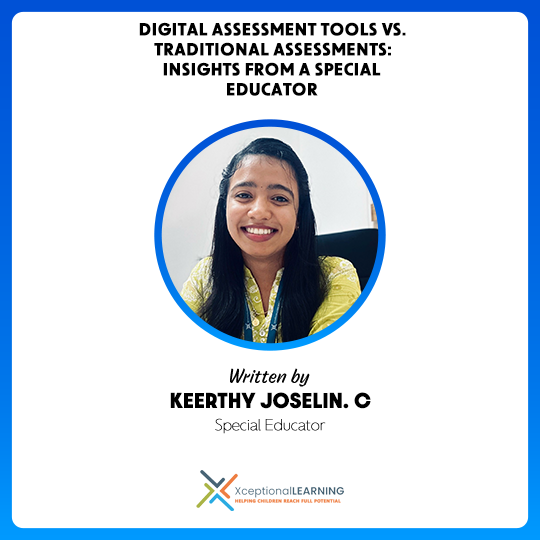Digital Assessment Tools vs. Traditional Assessments: Insights from a Special Educator
admin October 1st, 2025

Written by
Keerthy Joselin. C
Special Educator
Introduction
Traditionally, assessment has been used to rank, compare, and decide who’s doing better. It’s often about competition—who scores highest, who finishes fastest, who knows the most. But in special education, assessment serves a very different purpose. It’s not about who’s best—it’s about seeing each student for who they are. It’s a tool to honor the diverse strengths, challenges, and potential every learner brings to the classroom. Instead of measuring students against each other, we use assessment to understand how they learn, what supports they need, and how we can help them grow.
For decades, traditional paper-based tests have been the norm, providing structure and familiarity. However, with advancements in technology and a growing emphasis on inclusive education, digital assessment tools have emerged as a powerful alternative. They offer more flexible, inclusive, and personalized ways to capture student progress—tools that meet learners where they are, not where someone thinks they should be.
Challenges with Traditional Assessments
While paper-based exams have been reliable and standardized, they also come with inherent challenges, particularly for learners in special education:
- Limited Validity – Traditional tests often capture only surface-level knowledge and emphasize rote recall rather than deeper understanding.
- Accessibility Barriers – Students with fine motor difficulties, dyslexia, or slower writing speeds face unnecessary hurdles in demonstrating what they know.
- Low Engagement – Exams are often perceived as stressful, monotonous, and disconnected from interactive learning experiences.
- Delayed Feedback – Grading takes time, delaying interventions that could support student growth.
- Rigid Format – Even with accommodations like extra time, the paper-based structure remains largely inflexible, making it difficult to align with personalized learning plans.
Digital Assessments as a Solution
Digital tools address these challenges by offering flexible, student-centeredness, and data-driven approaches:
- Greater Validity and Accuracy – Adaptive platforms adjust the difficulty based on student responses, giving a clearer picture of learning progress.
- Accessibility Features – Speech-to-text, larger fonts, color contrast, and audio prompts allow students to demonstrate knowledge without being limited by physical or linguistic barriers.
- High Engagement – Interactive quizzes, gamified elements, and multimedia resources transform assessments into motivating learning opportunities.
- Instant Feedback – Automated scoring and detailed feedback help learners self-correct and enable teachers to respond immediately.
- Personalization – Assessments can be customized to align with Individualized Education Plans (IEPs), making them more inclusive and equitable.
Reduced Teacher Workload – Auto-grading and analytics dashboards free teachers from manual tasks, allowing more time for individualized support.
Comparative Overview
| Criteria | Traditional Assessments (Paper-based) | Digital Assessments (Online/Interactive) |
|---|---|---|
| Validity & Accuracy | Limited, prone to human bias, slower feedback | Automated scoring, adaptive testing, real-time insights |
| Student Comfort | Familiar, but stressful for slow writers or motor challenges | Accessible with speech-to-text, font adjustments, audio support |
| Engagement | Passive, recall-focused, often anxiety-inducing | Interactive, gamified, multimedia-rich, motivating |
| Special Education Suitability | Accommodations possible but limited flexibility | Highly adaptable: visuals, audio, personalization, IEP alignment |
| Feedback | Delayed, dependent on teacher | Instant, detailed, growth-oriented |
| Data Tracking | Minimal, one-time snapshot | Continuous tracking, progress monitoring, trend analysis |
| Equity | May disadvantage learners with disabilities | Promotes inclusivity and multiple means of expression |
Professional Reflection
In my classroom, I have witnessed firsthand how digital assessments can transform student experiences. For example, a learner who struggled to complete even a one-page written test was able to complete an online quiz using audio prompts and visual cues—accurately demonstrating understanding that would have otherwise gone unnoticed.
This is the real strength of digital assessments: they empower students to show their knowledge in ways that suit their abilities, not just their handwriting or memory recall. While traditional methods retain value in certain formal settings, digital tools bring inclusivity, adaptability, and real-time insight that special education demands.
Key Takeaway
Digital assessment tools are not just a modern replacement; they are an essential evolution. A hybrid model—combining the structure of traditional assessments with the flexibility of digital tools—ensures fairness, inclusivity, and accuracy for all learners.
As special educators, our mission is not simply to test knowledge but to celebrate progress, identify needs, and create pathways for success. Digital assessments bring us closer to this vision, making learning more equitable, engaging, and meaningful for every student.
Final Thoughts
Education is moving toward a future where assessments are not barriers but bridges—bridges that connect teachers to a deeper understanding of their students and learners to opportunities for success. Traditional paper-based tests will continue to hold their place in formal academic settings, but they cannot meet the diverse needs of today’s inclusive classrooms on their own.
Digital assessment tools, when thoughtfully integrated, provide the flexibility, accessibility, and engagement that learners—especially those with special needs—deserve. They allow us to see the whole child, not just the score on a test, and to tailor our teaching in ways that truly empower every student.
The ultimate goal is not to replace one method with another but to balance them—to create an assessment culture that values progress over perfection, inclusivity over rigidity, and growth over grades. That is the future of assessment in special education, and it is a future worth building together.
“With XceptionalLEARNING, access specialized therapy services and connect with licensed therapists online. Contact us today.”

